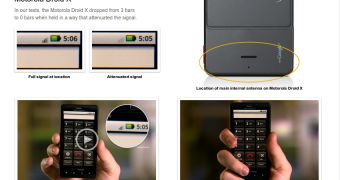Cupertino-based company Apple seems set to show to the world that the reception issues that its iPhone 4 was said to be plagued by are not limited to it. In fact, the company wants to show that, since there are so many smartphones affected by weakening of signal due to certain “grips of death,” the so called antenna issues with the iPhone 4 are no issues at all, and that this is actually something normal when it comes to holding a mobile phone in the hand.
Following demonstrations that included phones from RIM, HTC, Nokia and Samsung, Apple has added a new device to the list, namely the DROID X, showing that the most appealing devices on the market show similar behavior when held in certain ways. The special page Apple put in place for the 'antennagate' affair on its website displays video demos that include the iPhone 4 and iPhone 3GS, as well as the DROID Eris, Nokia N97 mini, Samsung Omnia II and now the DROID X.
According to Apple, all antennas (not restricted to mobile phones) “can experience attenuation.” When it comes to smartphones, “signal loss typically occurs when [the] hand attenuates the most sensitive part of the antenna.” The videos published on the company's website show how the aforementioned devices lose signal when the grip of death is applied. Since DROID X, one of the hottest smartphones on the market today, has just been added to the list, chances are that other devices would also emerge there.
It is rather interesting that Apple chose to approach the reception issues on its iPhone 4 this way. RIM, HTC, Nokia and Samsung already reacted to Apple's move, saying that there are no signal issues with their devices as the design avoids situation in which users would actually hold the phone is a way that affects the signal strength. For comparison, Apple chose to place the antenna on iPhone 4 into a steel bracket surrounding the mobile phone, which is permanently in contact with user's hand.
As stated above, DROID X is currently one of the most popular devices on the US market. Verizon Wireless, the carrier which launched it a few weeks ago, has run out of stock from day one, and says that the phone would ship to customers with delays. However, DROID X is not the only Android device out there selling like hot cakes. Recently, Google announced that it is activating 160,000 Android-based mobile phones a day (two devices per second, or 4,800,000 handsets each month), and the figure grows constantly.
Follow me on Twitter @ionut_arghire.

 14 DAY TRIAL //
14 DAY TRIAL //